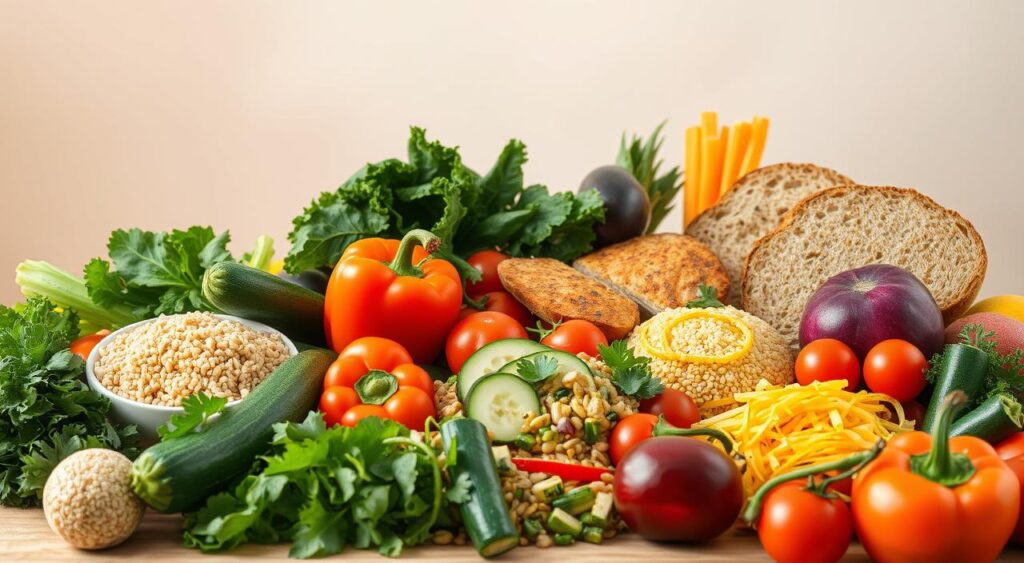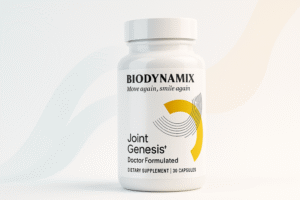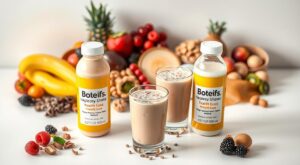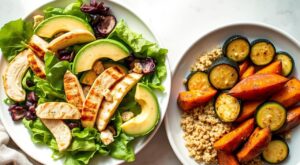Could eating less meat actually make your meals more exciting and your life healthier?
The flexitarian diet is a great way to start eating more plants. You don’t have to give up your favorite foods. It’s all about balance, with veggies, legumes, whole grains, and tasty sauces.
This diet became a top choice in 2024, thanks to its flexibility. You’ll enjoy dishes like Sweet Potato & Black Bean Chili. These meals are comforting and full of flavor.
In this article, you’ll find recipes and tips for easy meal prep. You can freeze leftovers and try new things without worrying about calories. It’s perfect for anyone looking to eat more plants, whether you’re just starting or already a fan.
What is the flexitarian diet and why it works for you
The flexitarian diet is all about enjoying plant-based meals with the occasional animal food. It’s ranked as the best plant-based diet by U.S. News & World Report in 2024. This shows that experts think it’s a great choice for a healthy lifestyle.
Definition and philosophy
The flexitarian diet is simple: plants are the main focus, with room for animal foods. It’s about being flexible, not perfect. You can have a vegetarian meal one day and add chicken to a salad the next. It’s all about making healthy choices that fit your life.
Health benefits backed by evidence
Studies show that eating more plants can lower heart disease risk, help with weight, and reduce type 2 diabetes risk. This is because plants are full of fiber and nutrients. Even small changes in your diet can make a big difference over time.
Environmental and sustainable living advantages
Eating less meat helps the planet by using less land, water, and energy. Small changes can add up and make a big difference. The flexitarian diet is a smart choice for those who want to live more sustainably without giving up all animal foods.
| Focus | Typical Choices | Primary Benefit |
|---|---|---|
| Plant-first meals | Legumes, whole grains, vegetables, nuts | Improved fiber and nutrient intake |
| Occasional animal foods | Lean poultry, fish, dairy in small portions | Dietary flexibility and ease of social dining |
| Mix-and-match recipes | Vegetarian lasagna, bean-based chili, mixed bowls with a bit of meat | Satisfying flavors while reducing meat consumption |
| Environmental impact | Less red meat, more legumes and veggies | Lower carbon footprint and support for sustainable living |
How to transition to a flexitarian lifestyle without stress
Transitioning to flexitarian eating is easy. Start with small steps that fit your life. Choose a few favorite recipes, like Sweet Potato & Black Bean Chili or sun-dried tomato pasta. Make extra for lunches and the freezer. This makes meatless choices feel normal.
Start small: meatless days and gradual changes
Begin with one meatless day a week, like Meatless Monday. Add another when you’re ready. Meatless days help you get used to plant-based meals without stress.
Try dishes like farrotto or panang curry with squash. These keep meals flavorful and make cutting down on meat a choice, not a sacrifice.
Practical tips from dietitians for sustainable habits
Follow dietitian advice to build lasting habits. Start slow and find a few vegetarian recipes you like. Prep veg trays and cooked grains for quick, healthy meals.
Plan lunches and cook dinners in advance to avoid fast food. If you do eat meat, use small amounts. This makes the change easier and more sustainable.
Swapping strategies: beans, lentils, tofu, and mushrooms
Replace meat with plant-based options that match familiar dishes. Use beans or lentils for tacos and bolognese. Crumble tofu or sauté mushrooms as meat substitutes. These add protein, fiber, and texture.
Try simple seasonings and sauces to make swaps feel special. Over time, these swaps will reduce your need for animal products. This makes reducing meat consumption easy and stress-free.
Pantry staples and essentials for plant-based eating
Having a well-stocked pantry makes it easy to eat plant-based on busy nights. Keep a mix of long-lasting items and quick fixes. This way, you can make meals without stress.
Long-shelf staples: canned beans, whole grains, and pasta
Begin with reliable basics. Canned beans are great for salads, stews, and wraps. Whole grains like farro, brown rice, and quinoa add texture and are good in one-pot meals.
Keep shelf-stable pasta and gnocchi for quick meals. Tomato paste, coconut milk, and peanut butter enhance sauces and curries.
Fresh produce and prep-friendly vegetables
Stock up on versatile veggies. Carrots, bell peppers, and onions last long and cook fast. Use precut salad bar veggies or frozen greens to save time.
Pair fresh produce with canned beans or whole grains for balanced meals. These meals are filling and nutritious.
Flavor boosters: sun-dried tomatoes, miso, spices, and oils
Enhance flavors with concentrated ingredients. Sun-dried tomatoes and their oil elevate simple pasta dishes. Miso, dried mushrooms, and kombu add umami to vegetarian broths.
A small spice collection and good oils can finish dishes with a kick. These items transform pantry staples into memorable meals.
Quick shopping checklist
- 2–4 varieties of canned beans for salads, chili, and hummus
- Three whole grains: farro, brown rice, quinoa
- Frozen vegetables and precut fresh veg for fast prep
- Sun-dried tomatoes, miso paste, tomato paste, coconut milk
- Quality olive oil, peanut butter, and a basic spice rack
With these pantry items, you can mix canned beans, whole grains, and bold flavors. This supports a flexible and satisfying plant-based diet.
How to balance meals for nutrition on a semi-vegetarian plan
Eating semi-vegetarian is flexible and keeps your diet balanced. Focus on whole foods, simple swaps, and pairing ingredients. This makes meals satisfying and keeps your plate varied and nutrient-rich.
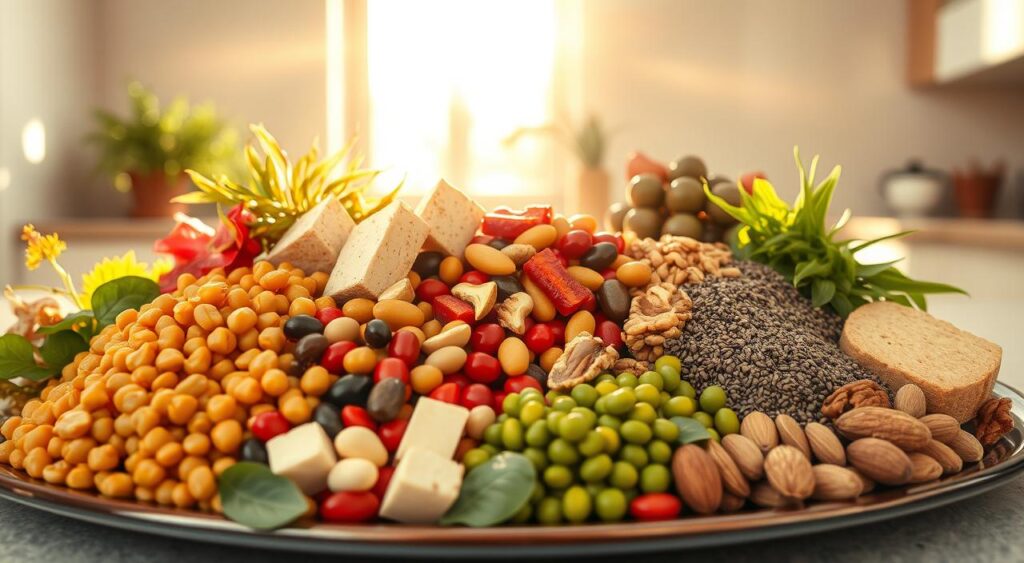
Protein combinations to replace or stretch animal protein
Mix beans, lentils, tofu, and whole grains for complete proteins. Try black beans with brown rice, chickpeas in stews, or tofu crumbles in tacos. These combos boost texture and satiety in many dishes.
For extra flavor, add a small amount of fish, chicken, or sausage to legume-rich dishes. Farro, quinoa, and barley are high in protein and fiber, making meals more filling.
Micronutrients to watch: B12, iron, calcium
Reducing meat intake can lower some nutrients. Plan for B12, iron, and calcium in your meals. Fortified cereals or dairy alternatives can help with B12. Lentils, spinach, and pumpkin seeds are good for iron, and vitamin C foods like bell peppers or citrus improve absorption.
Dairy, yogurt, or fortified plant milks are good for calcium. If you’re pregnant, older, or have special needs, talk to a dietitian or your doctor about testing and supplements. Learn more about flexitarian patterns at this resource.
Meal-building template: protein + grain + veg + healthy fat
Use a simple template to make balanced plates: plant-based protein, whole grain, vegetables, and healthy fat. This structure supports semi-vegetarian nutrition and makes cooking easier.
Examples include lentils + farro + roasted Brussels sprouts + olive oil, or tofu + brown rice + sautéed greens + avocado. Rotate ingredients to cover a range of vitamins and minerals over the week.
| Plate Component | Good Options | Why it helps |
|---|---|---|
| Protein | Chickpeas, lentils, tofu, tempeh, Greek yogurt | Provides satiety and plant-based protein to replace meat |
| Grain | Farro, quinoa, brown rice, whole-wheat pasta | Boosts amino acid profile and fiber |
| Vegetable | Leafy greens, crucifers, bell peppers, tomatoes | Supplies vitamins, minerals, and antioxidants |
| Healthy Fat | Olive oil, avocado, nuts, seeds | Improves nutrient absorption and adds flavor |
Use these ideas to build meals that meet your taste and health goals. With varied protein combos and attention to B12, iron, and calcium, your semi-vegetarian nutrition can be satisfying and nourishing.
Sweet Potato & Black Bean Chili — hearty vegetarian comfort
This sweet potato black bean chili is perfect for any time. It combines roasted sweet potatoes, black beans, and spices for a nutritious meal. It’s great for weeknights and can be made in bulk for potlucks.
Why this recipe fits the flexitarian approach:
The mix of beans and veggies gives you protein and keeps you full. It’s a great choice for those who want to eat less meat but don’t want to give up comfort food.
Ingredient swaps and make-ahead tips:
- Trade chipotle for smoked paprika if you prefer mild heat.
- Add cooked lentils or a half cup of browned lean ground turkey for a hybrid version when you want extra heft.
- Make-ahead vegetarian chili works well: cook a double batch, cool, and portion for the week.
Storage and freezing advice:
Cool the chili completely before sealing in airtight containers. Freeze in single-serve portions for easy lunches. Thaw overnight in the fridge or gently reheat on the stove; the texture holds up well after freezing.
Serve with tortilla chips, warm cornbread, or a crisp slaw. This sweet potato black bean chili is a reliable make-ahead vegetarian chili that supports meal planning and long-term habits around reducing meat consumption.
Spaghetti & Spinach with Sun-Dried Tomato Cream Sauce — fast weeknight pasta
This quick recipe uses common ingredients for a tasty meal. Start with oil-packed sun-dried tomatoes for a rich flavor. Then, mix in hot spaghetti and fresh spinach to wilt it. Finish with cream or a plant-based option for a smooth sauce.

Begin by sautéing garlic and shallot in the sun-dried tomato oil. Add chopped tomatoes, a bit of pasta water, and cream. Mix in cooked spaghetti and spinach until the spinach just wilts. This method keeps the spinach fresh and speeds up dinner.
How to add protein to pasta: Add chickpeas or white beans for a protein boost. You can also use firm tofu or seared tofu cubes. For seafood lovers, frozen shrimp works well.
For a quicker option, choose whole-grain or lentil pasta. Grated Parmesan or a soft-cooked egg can also be added. These changes make the dish adaptable to different tastes in plant-based eating.
Save time with substitutions like oil-packed sun-dried tomatoes and frozen spinach. You can also use pre-spiraled zucchini or store-bought gnocchi. These changes make this dish a top choice for quick, satisfying meals.
Mediterranean chickpea stew for easy crock-pot dinners
You’ll adore a vegetable-rich Mediterranean chickpea stew. It cooks all day and emerges full of flavor. Just set your crock pot, then finish with olive oil and parsley. This makes weeknights easy and stress-free.
Slow-cooking plant-based meals is a game-changer. It lets tomatoes, onions, and spices blend into a rich base. Chickpeas stay tender, and flavors intensify, all without effort. This frees up your evenings and reduces stress.
Want to mix things up? Swap chickpeas for white beans for a softer texture. Add kale or Swiss chard for a burst of color and flavor. Stir in lentils for extra protein, perfect for semi-vegetarian meals.
For simple sides, try it over brown rice or farro. A slice of whole-grain bread soaks up the broth beautifully. For extra filling, top with pine nuts or Greek yogurt if allowed.
Tofu taco filling and versatile taco bowl ideas
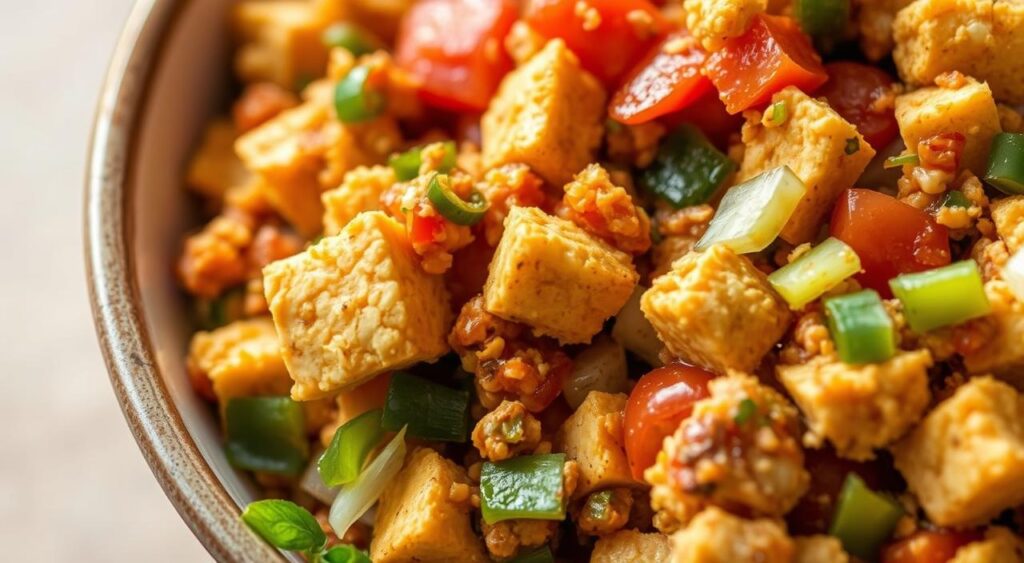
Begin with extra-firm tofu, crumbled into small pieces. Remove excess water and sauté with spices like cumin and smoked paprika. Add garlic powder and a bit of soy sauce for a meaty flavor.
For added texture and protein, mix in black beans or cooked lentils. This combination creates delicious plant-based tacos. It’s perfect for those cutting down on meat without sacrificing taste.
Crumbled tofu seasoning to mimic savory ground meat
First, toast the spices in the pan to release their scent. Then, add tofu and a bit of tomato paste for depth. Finish with a squeeze of lime to brighten the flavors. Adjust the seasoning to match your favorite taco filling.
To add chewiness, sauté diced mushrooms with the tofu. The mushrooms’ umami enhances the dish, appealing to both meat-eaters and vegetarians.
How to turn the filling into burritos, bowls, and nachos
Use the same filling for different meals to save time. Turn it into burritos, taco bowls, or nachos. This versatility makes meal prep easy.
Pre-cooked rice, canned beans, and jarred peppers make assembly quick. Follow recipe ideas on vegetarian diet for weight loss for a plant-forward eating plan.
Quick toppings that boost nutrients
Top with pico de gallo, avocado, cilantro, and cabbage for crunch. Add roasted corn, Greek yogurt, or cashew crema for creaminess and protein.
For quick meals, use canned beans, pre-shredded cabbage, and ready-made salsas. These toppings enhance flavor and support a meat-reduced diet. They make for tasty, flexible meals.
One-pot gnocchi with tomato and leek sauce — quick and crispy
This one-pot gnocchi recipe is a weeknight winner. It’s ready in about 20 minutes. You cook store-bought gnocchi in hot oil for a crispy outside and soft inside.
The pan fond adds deep flavor to the tomato and leek sauce. It’s easy and quick to make.
Why store-bought gnocchi speeds dinner prep
Using store-bought gnocchi saves time and effort. It’s great for quick dinners. Choose a good brand and cook it straight from the package.
Optional additions and whole-grain swaps
Adding whole-wheat gnocchi boosts fiber. It keeps you full longer. For a bit of protein, serve with shrimp or a pork chop.
For a plant-based meal, try plant-based pasta or add beans. Use pesto for a green, rich flavor.
Getting texture right: searing for fond and flavor
Start with a hot pan and oil. Sear gnocchi until golden. This creates a fond layer.
Remove some gnocchi, then deglaze with tomatoes or wine. This pulls up the browned bits. Return the gnocchi and add sliced leeks to soften in the sauce.
For a crisp bite, cook in batches if needed. Finish with Parmesan or pesto for a cheesy or herb finish.
For more flexitarian dinner tips, see this guide: flexitarian dinner tips.
Lentil shepherd’s pie — plant-based comfort with protein
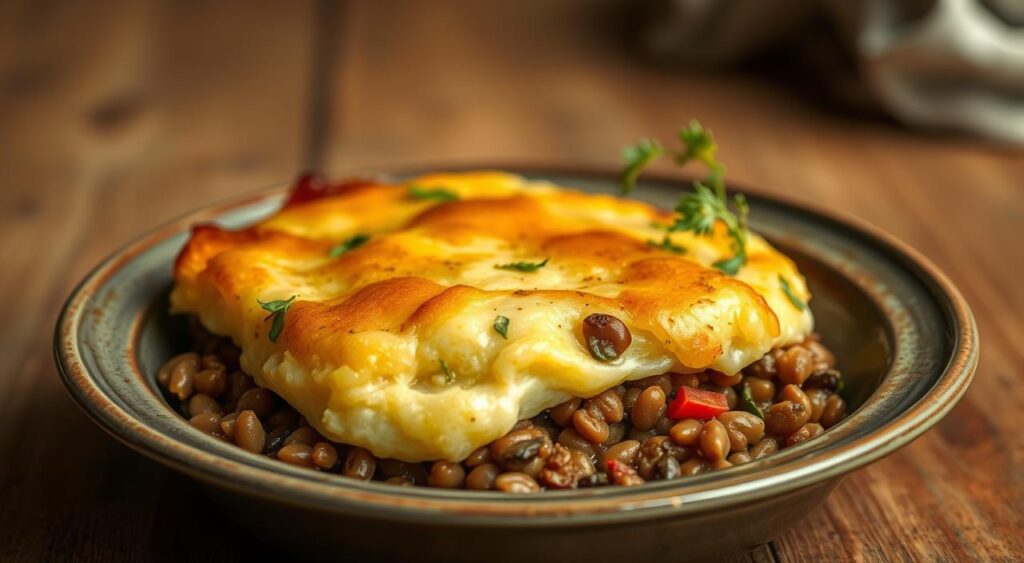
This hearty meal shows plant-based food can be easy, tasty, and packed with protein. It has a rich, savory base and creamy mash on top. Everyone will feel like they’re enjoying a classic dish, without the meat.
Swapping lentils for ground meat
Lentils beat ground meat in fiber and calories. They soak up flavors like herbs, onions, and vegan sauce. This makes them taste deep and satisfying. Brown or green lentils work best for a beef-like texture.
Shortcut tips for faster assembly
Use precooked lentils or canned lentils to save time. For the mash, try instant potatoes or cauliflower mash. Add vegan butter and plant milk for a smooth finish.
Gluten-free and vegan adaptations
To keep it gluten-free, use cornstarch or gluten-free flour for thickening. For a vegan version, replace dairy butter with Earth Balance. Make sure your stock and seasonings are gluten-free.
This lentil shepherd’s pie is great with a salad or roasted carrots. It’s perfect for a balanced meal that’s good for flexitarian diets. The recipe is easy to scale up and reheats well, making it ideal for busy weeknights.
Jackfruit burrito bowls and plant-based pulled “meat” options
Young jackfruit makes a great base for a jackfruit burrito bowl. It tastes like pulled meat but is plant-based. Its texture is perfect for soaking up sauces, making it a great flexitarian option.
To make it, cook jackfruit with spices until it’s tender. Start with canned young jackfruit, drain it, and then add garlic, smoked paprika, and chipotle. Add tomato or barbecue sauce for flavor. Let it simmer until it’s tender and can be pulled apart.
Cooking jackfruit to absorb bold sauces
Break the jackfruit into small pieces before cooking. This lets it soak up more sauce. Use stock or beer for extra flavor. For a crispy texture, sear the shredded jackfruit in a hot pan.
Protein and fiber pairings for satiety
Combine the jackfruit with black beans, brown rice, or lentils for more protein and fiber. Beans and grains give you lasting energy. Add corn, sweet potato, or avocado for extra nutrition.
How to use this filling across meals
Make a big batch and use it all week. It’s great in quesadillas, nachos, and salads. Reheat it with a bit of water or sauce to keep it moist. These recipes are perfect for meal prep and exploring plant-based options.
Pasta primavera with Brussels sprouts and mushrooms — veggie-forward pasta
You can whip up a quick, vibrant pasta primavera with Brussels sprouts and mushrooms. Start with pre-sliced mushrooms and thinly sliced sprouts. This way, they cook together in one pan.
Toss the veggies with olive oil, garlic, lemon, and a bit of pasta water. This creates a silky sauce that sticks to the pasta.
Opt for whole-grain pasta or a legume-based shape to increase fiber and protein. This makes the dish more filling without needing meat. Adding toasted almonds or white beans boosts texture and plant protein.
Use quick-cook veggies like baby spinach, snap peas, or thin-sliced sprouts to save time. Sauté mushrooms until they brown, then add the quick-cook veggies for a minute. This keeps them bright and preserves nutrients, ready in under 20 minutes.
For serving, pair the pasta with a simple vinaigrette salad or steamed greens. Top with Parmesan or nutritional yeast, lemon wedges, and pepper to enhance flavors.
Here’s a cheat-sheet to help you pick pasta bases and protein add-ins for your next meal.
| Component | Benefits | Quick Tip |
|---|---|---|
| Whole-grain pasta | Higher fiber, fuller longer, familiar texture | Cook 1–2 minutes longer than regular pasta for best bite |
| Legume-based pasta | More protein per serving, gluten-free options available | Rinse briefly after cooking to stop clinginess |
| Sliced Brussels sprouts | Fast cooking, nutty flavor, great in Brussels sprouts recipes | Use a mandoline or chef’s knife to get even thin slices |
| Mushrooms (presliced) | Umami boost, soaks up sauce, low prep | Sear until browned to concentrate flavor |
| Toasted nuts or seeds | Crunch and healthy fats, raises satiety | Toast in a dry skillet for 2–3 minutes until fragrant |
| White beans or cannellini | Extra plant protein, creamy texture | Fold in at the end to warm without breaking apart |
Flexitarian diet friendly swaps for traditional comfort dishes
You can make your favorite comfort meals healthier without losing flavor. Swap heavy meat for legumes, mushrooms, or roasted veggies. This keeps the dish hearty and tasty. Making small changes helps cut down on meat while keeping family favorites.
Converting classics
Turn lasagna into a veggie version with eggplant, spinach, and ricotta or plant-based cheese. For pot pie, use mushrooms and root veggies with a flaky top. Replace beef in curry with squash or chickpeas; spices keep the flavor rich.
Recipe-style examples
Try farrotto, a fiber-rich farro risotto, for a healthier option. Make a veggie chili with beans, tomatoes, and smoked paprika for flavor. For noodle dishes, simmer a mushroom udon broth for a meaty taste.
Stretching meat without losing taste
Use semi-veggie swaps to stretch meat. Mix lentils with a bit of Italian sausage for a rich sauce. Top a dish with shrimp for a special touch.
When to add animal protein
Think of animal protein as a garnish, not the main dish. A soft-cooked egg on a grain bowl, a few slices of pork in a stew, or grated Parmesan can boost flavor. This way, you enjoy familiar tastes while eating less meat.
Practical swaps list
- Ground beef → crumbled tempeh or lentils for Taco Night
- Beef stew → mushroom and barley stew with thyme
- Chicken pot pie → mushroom, leek, and root vegetable pot pie
- Beef curry → panang curry with squash and tofu
- Classic lasagna → vegetarian lasagna with eggplant and béchamel
Flexitarian swaps bring comfort and balance. Small changes let you enjoy your favorites, explore new flavors, and reduce meat. You stay flexible and satisfied.
Conclusion
Adopting the flexitarian diet can be easy and stress-free. Begin by making simple swaps and enjoying recipes like Sweet Potato & Black Bean Chili or Sun-Dried Tomato Pasta. Double batches for busy nights to keep meals satisfying and sustainable.
Flexibility is key: you’ll mostly eat plants but sometimes include meat or seafood. Use beans, lentils, tofu, and mushrooms to add protein and flavor. These vegetarian meals often rival meat dishes in taste and texture, making it easier to stick to a balanced diet.
Health and environmental benefits make the flexitarian diet even more appealing. It can lower heart disease risk, aid in weight management, and reduce type II diabetes risk. Plus, it’s better for the planet. Start small, prep veggies for snacks, and follow dietitian advice to build lasting habits that support your goals.

